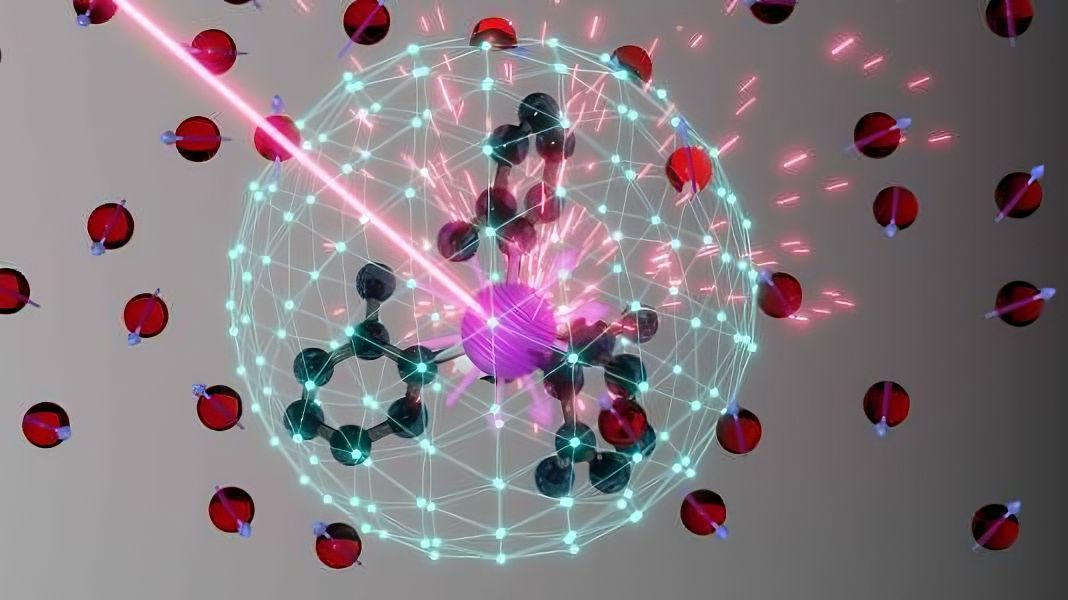
[ad_1]

சுற்றியுள்ள படிகத்தின் கட்டமைப்பை குறைந்த சமச்சீராக மாற்றுவதன் மூலம் மூலக்கூறு குவிட்டின் வாழ்நாளை நீட்டிக்க முடியும் என்று விஞ்ஞானிகள் காட்டியுள்ளனர். சமச்சீரற்ற தன்மை குவிட்டை இரைச்சலில் இருந்து பாதுகாக்கிறது, இது ஒரு சமச்சீர் கட்டமைப்பில் வைக்கப்பட்டிருப்பதை விட ஐந்து மடங்கு அதிக நேரம் தகவல்களை பராமரிக்க உதவுகிறது. கடன்: MIT/Dan Laorenza
சமச்சீரற்ற நிலைத்தன்மை
சுற்றுச்சூழலின் சமச்சீர்நிலையை உடைப்பதன் மூலம், விஞ்ஞானிகள் தகவல்களைத் தக்கவைத்துக்கொள்ளும் நேரத்தை நீட்டிப்பதற்கான ஒரு புதிய நுட்பத்தை நிரூபிக்கின்றனர்.
என்ன நடந்தது
சுற்றியுள்ள படிகத்தின் கட்டமைப்பை குறைந்த சமச்சீராக மாற்றுவதன் மூலம், அவை ஒரு மூலக்கூறு குவிட்டின் வாழ்நாளை நீடிக்கலாம் என்று விஞ்ஞானிகள் காட்டியுள்ளனர்.
குவிட் சமச்சீரற்ற தன்மையால் இரைச்சலில் இருந்து பாதுகாக்கப்படுகிறது, இது ஒரு சமச்சீர் கட்டமைப்பில் வைக்கப்பட்டிருப்பதை விட ஐந்து மடங்கு நீண்ட தகவலைப் பாதுகாக்க அனுமதிக்கிறது. சமச்சீர் படிக ஹோஸ்டில் 2 மைக்ரோ விநாடிகளின் மூலக்கூறு குவிட்டின் ஒத்திசைவு நேரத்துடன் ஒப்பிடும்போது, 10 மைக்ரோ விநாடிகள் அல்லது ஒரு வினாடியின் 10 மில்லியனில் ஒரு ஒத்திசைவு நேரத்தை (குபிட் தகவலைப் பராமரிக்கும் நேரம்) ஆய்வுக் குழு பெற்றது.
இதழில் வெளியிடப்பட்ட கண்டுபிடிப்புகள் உடல் மதிப்பாய்வு Xஎன்ற விஞ்ஞானிகள் குழுவால் தயாரிக்கப்பட்டது மாசசூசெட்ஸ் தொழில்நுட்ப நிறுவனம், ஆர்கோன் தேசிய ஆய்வகம் இன் அமெரிக்க எரிசக்தி துறை (DOE), வடமேற்கு பல்கலைக்கழகம்தி சிகாகோ பல்கலைக்கழகம்மற்றும் இந்த கிளாஸ்கோ பல்கலைக்கழகம். Q-NEXT, ஆர்கோனால் நடத்தப்படும் DOE தேசிய குவாண்டம் தகவல் அறிவியல் ஆராய்ச்சி மையம், ஆராய்ச்சிக்கு நிதியளித்தது.
கொஞ்சம் பின்னணி
- ஒரு குவிட் என்பது குவாண்டம் தகவலின் அடிப்படை அலகு, பாரம்பரிய கம்ப்யூட்டிங் பிட்டின் குவாண்டம் அனலாக் ஆகும்.
- சத்தம், அல்லது குறுக்கிடும் சிக்னல்கள், தகவலை அழிக்கும் முன், Qubits நீண்ட காலத்திற்கு மட்டுமே தகவலை வைத்திருக்க முடியும். தகவல் நிலையானதாக இருக்கும் காலத்தை நீட்டிப்பது, ஒத்திசைவு நேரம் என அழைக்கப்படுகிறது, இது குவாண்டம் தகவல் அறிவியலில் மிகப்பெரிய சவால்களில் ஒன்றாகும்.
- க்யூபிட்கள் வெவ்வேறு வகைகளில் வருகின்றன, அவற்றில் ஒன்று ஆய்வகத்தால் வடிவமைக்கப்பட்ட மூலக்கூறு. மூலக்கூறு குவிட்கள் மட்டுப்படுத்தப்பட்டவை, அதாவது அவை ஒரு சூழலில் இருந்து நகர்த்தப்பட்டு மற்றொரு சூழலில் எளிதாக வைக்கப்படும். இதற்கு நேர்மாறாக, குறைக்கடத்திகளால் ஆனவை போன்ற பிற வகையான குவிட்கள் அவற்றின் சூழலுடன் மிகவும் இணைக்கப்பட்டுள்ளன.
அது ஏன் முக்கியம்
- நீண்ட ஒத்திசைவு நேரம்: நீண்ட ஒத்திசைவு நேரங்கள், கம்ப்யூட்டிங், தொலைதூரத் தொடர்பு மற்றும் மருத்துவம், வழிசெலுத்தல் மற்றும் வானியல் போன்ற பகுதிகளில் உணர்தல் போன்ற பயன்பாடுகளில் மிகவும் பயனுள்ள குவிட்களை உருவாக்குகின்றன.
- மாடுலாரிட்டி: குவிட்டின் வீட்டுவசதியை மாற்றுவதன் மூலமோ அல்லது அதன் வீட்டுவசதியுடன் ஒப்பிடும்போது சமச்சீரற்ற நிலையில் வைப்பதன் மூலமோ ஒத்திசைவு நேரத்தை நீட்டிக்க முடியும் என்பதால், நீண்ட ஆயுட்காலத்தை அடைய குவிட்டையே மாற்ற வேண்டிய அவசியமில்லை. அதன் நிலையை மாற்றினால் போதும்.
“மூலக்கூறு வேதியியல், குவிட்டை வழங்கும் படிகப் பொருளை மாற்றுவதற்கும், குவிட்டையே மாற்றுவதற்கும் உதவுகிறது” என்று எஃப்ஜி கீஸ் வேதியியல் பேராசிரியரான டான்னா ஃப்ரீட்மேன் கூறினார்.[{” attribute=””>MIT and paper co-author. “Adding in this new level of control is very powerful.”
“The change was realized just by interchanging single atoms on the host molecules, one of the smallest changes you could get, and it gave rise to the five-fold enhancement in coherence time,” said the University of Glasgow’s Sam Bayliss, who co-authored the study. “It’s a nice demonstration of this atomic-level tunability that you get with molecules. Chemical techniques intrinsically provide control on the level of single atoms, which is a dream in a lot of modern technologies.”
- Variability: The effectiveness of this symmetry-breaking technique means that molecular qubits can operate in a wide variety of environments, even those in which noise can’t be reduced.
“We’ve created a new handle for modifying coherence properties in molecular systems,” Freedman said. “This newfound ability to chemically control the host environment opens up new space for targeted applications of molecular qubits.”
“While 10 microseconds may not sound extremely long compared to some systems, keep in mind that we didn’t do anything to reduce the noise sources. In the environments we measured, the noise is very significant. So even though there’s noise there, the qubits basically don’t see it,” Bayliss said. “And why don’t we just remove the noise source? In practical cases, it’s not always possible to operate in an environment that is ultrapure. So having a qubit that can operate intrinsically in a noisy environment can be advantageous.”
The details
- The team’s qubit is made of a chromium-based ion attached to carbon-based molecules.
- For a molecular qubit, the main source of noise is the magnetic fields in its surroundings. The magnetic fields tend to jostle the qubit’s energy levels, which encode the information. The crystal’s asymmetry shields the qubit from the potentially disruptive magnetic fields, and the information is preserved for longer.
- In addition to improving the qubit’s properties, the team developed a mathematical tool that accurately predicts any molecular qubit’s coherence time based on the structure of the host crystal.
“This is incredibly exciting for us,” Bayliss said. “One of the very exciting things was just how much of an advancement could be made with these systems over a short space of time, and how small some of the modifications to the host matrix can be to get quite a significant improvement.”
“I’m delighted to observe a new, exciting feature of molecular chemistry,” Freedman said.
“This is an important development. Being able to precisely tune a qubit’s environment is a unique advantage of molecular qubits. This can’t be easily done within other material systems,” said Q-NEXT Director and paper co-author David Awschalom, who is also an Argonne senior scientist, vice dean of Research and Infrastructure and the Liew Family Professor of Molecular Engineering and physics at the University of Chicago’s Pritzker School of Molecular Engineering, and the director of the Chicago Quantum Exchange. “Knowing we can extend a qubit’s lifetime by engineering its environment opens new possibilities for applications across quantum computing, sensing, and communication.”
Reference: “Enhancing Spin Coherence in Optically Addressable Molecular Qubits through Host-Matrix Control” by S. L. Bayliss, P. Deb, D. W. Laorenza, M. Onizhuk, G. Galli, D. E. Freedman and D. D. Awschalom, 18 August 2022, Physical Review X.
DOI: 10.1103/PhysRevX.12.031028
The study was funded by the U.S. Department of Energy Office of Science National Quantum Information Science Research Centers and the Office of Basic Energy Sciences.
[ad_2]